Monday, April 02, 2012 9:36:21 PM
~ IAMLEGEND STOCK LESSON #19 ~ " ELLIOT WAVES-LEGS"
** Link back for more lessons **
Elliott Wave


Elliott Wave Theory was developed by R.N. Elliott and popularized by Robert Prechter. This theory asserts that crowd behavior ebbs and flows in clear trends. Based on this ebb and flow, Elliott identified a certain structure to price movements in the financial markets. The article serves as a basic introduction to Elliott Wave Theory. A basic 5-wave impulse sequence and 3-wave corrective sequence are explained. While Elliott Wave Theory gets much more complicated than this 5-3 combination, this article will only focus on the very basics.

The trends start with the largest degree (GrandSuper Cycle) and work their way down to waves of lesser degree. For example, the Cycle wave is one larger degree than the Primary wave. Conversely, the Primary wave is one lesser degree than the Cycle wave. Wave 1 of (1) would indicate that Wave 1 is part of a larger degree Wave (1). Wave 1 is a lesser degree than Wave (1).
Types of waves: Impulse and Corrective
Impulse waves move in the direction of the larger degree wave. When the larger degree wave is up, advancing waves are impulsive and declining waves are corrective. When the larger degree wave is down, impulse waves are down and corrective waves are up. Impulse waves, also called motive waves, move with the bigger trend or larger degree wave. Corrective waves move against the larger degree wave.


A basic corrective wave forms with three waves, typically a, b and c. The chart below shows an abc corrective sequence. Notice that waves a and c are impulse waves (green). This is because they are in the direction of the larger degree wave. This entire move is clearly down, which represents the larger degree wave. Waves a and c move with the larger degree wave and are therefore impulse waves. Wave b, on the other hand, moves against the larger degree wave and is a corrective wave (red).

Combining a basic 5 wave impulse sequence with a basic 3 wave corrective sequence yields a complete Elliott Wave sequence, which is a total of 8 waves. According to Elliott, this complete sequence is divided into two distinct phases: the impulse phase and the corrective phase. The abc corrective phase represents a correction of the larger impulse phase.



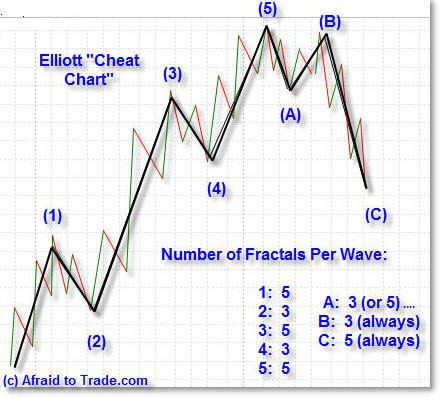
Three Rules
Believe it or not, there are only three rules when it comes to interpreting Elliott Wave. There are many guidelines, but only three HARD rules. These are unbreakable. Guidelines, on the other hand, are bendable and subject to interpretation. Furthermore, these rules only apply to a 5-wave impulse sequence. Correction, which are much more complicated, are given more leeway when it comes to interpretation.
Rule 1: Wave 2 cannot retrace more than 100% of Wave 1.
Rule 2: Wave 3 can never be the shortest of the three impulse waves.
Rule 3: Wave 4 can never overlap Wave 1.

Wave 2 cannot move below the low of Wave 1. A break below this low would call for a re-count. Even though Wave 3 is typically the longest of the three impulse waves, there is a specific rule that it cannot be the shortest. 1 or 5 can be longer than Wave 3, but both cannot be longer than Wave 3. It is probably best to use percentages or log scales when measuring Wave length. Elliott Wave indicates that Wave 3 must exceed the high of Wave 1. Failure to exceed this high would call for a re-count. Impulse moves are all about making progress. Failure to exceed the high of Wave 2 would not be making progress. The third, and final rule, is that Wave 4 cannot overlap Wave 1, which means the low of Wave 4 cannot exceed the high of Wave 1. Such a violation would call for a re-count.
Guidelines
Guideline 1: When Wave 3 is the longest impulse wave, Wave 5 will approximately equal Wave 1.
Guideline 2: The forms for Wave 2 and Wave 4 will alternate. If Wave 2 is a sharp correction, Wave 4 will be a flat correction. If Wave 2 is flat, Wave 4 will be sharp.
Guideline 3: After a 5-wave impulse advance, corrections (abc) usually end in the area of prior Wave 4 low.

The first guideline is useful for targeting the end of Wave 5. Even though Wave 5 could be longer than Wave 3 and Wave 3 could still be longer than Wave 1, chartists can make initial Wave 5 projections once Wave 4 ends. In a larger uptrend, chartists simply apply the length of Wave 1 (percentage change) to the low of Wave 4 for an upside target. The opposite is true for a 5-wave decline. The percentage decline in Wave 1 would be applied to the high of Wave 4 for a Wave 5 estimate.
The guideline of alternation (2) is useful for determining the time of correction for Wave 4. After a sharp decline for Wave 2, chartists can expect a relatively flat correction for Wave 4. If Wave 2 is relatively flat, then chartists can expect a relatively sharp Wave 4. In practice, Wave 2 tends to be a rather sharp wave that retraces a large portion of Wave 1. Wave 4 comes after an extended Wave 3. This Wave 4 marks more of a consolidation that lays the groundwork for a Wave 5 trend resumption.
The third guideline is useful for estimating the end of a Wave II correction after a Wave I advance. Waves I and II are the larger degree waves. Waves 1-2-3-4-5 are lesser degree waves within Wave I. Once the Wave II correction unfolds, chartists can estimate its end by looking at the end of the prior wave 4 (lesser degree wave 4). In a larger degree uptrend, Wave II would be expected to bottom near the low of lesser degree Wave 4. In a larger degree downtrend, Wave II would be expected to peak near the high of lesser degree Wave 4.



Contracting Triangle
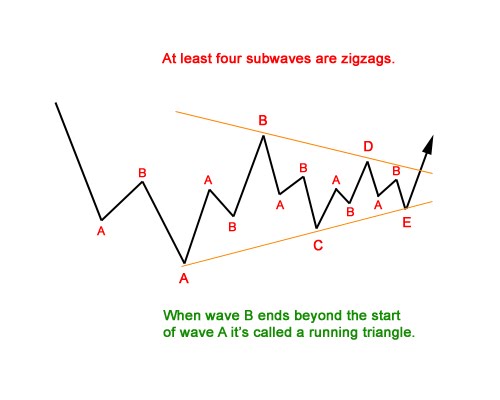
Barrier Triangle
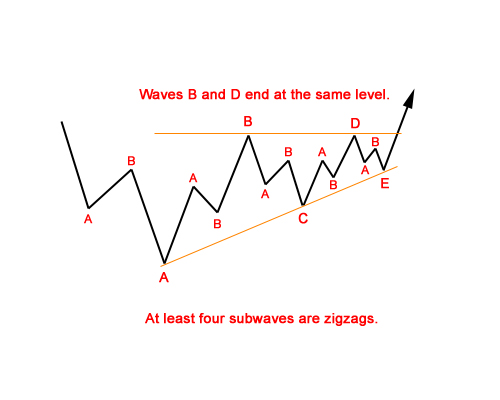
Expanding Triangle
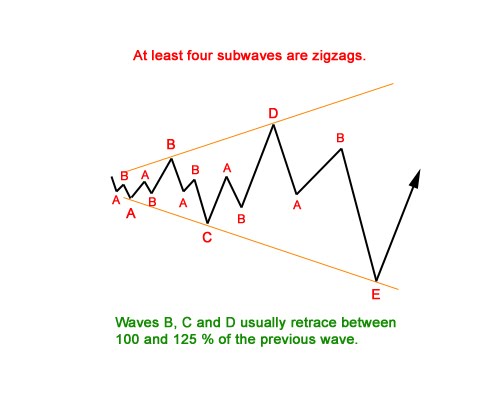
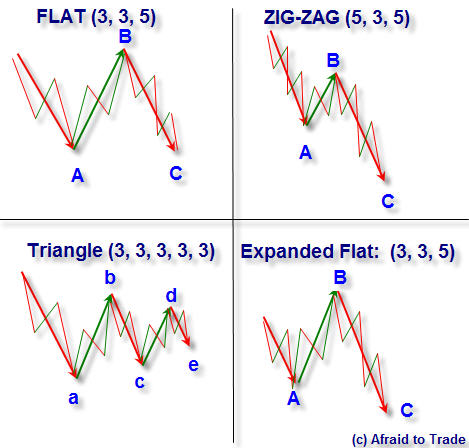
EXAMPLES :

















VIDEO'S
http://www.youtube.com/watch?v=wgz_V8Q8JK4&feature=related
http://www.youtube.com/watch?v=a50WqgZUqKE&feature=relmfu
http://www.youtube.com/watch?v=Ce2QV637gEk&feature=relmfu
http://www.youtube.com/watch?v=a1D2Ijj3YTk&feature=relmfu
http://www.youtube.com/watch?v=cdtTx2roaqo&feature=relmfu
http://www.youtube.com/watch?v=KvhIh2rU0R0
http://www.youtube.com/watch?NR=1&feature=endscreen&v=HcDysbOyn8A
http://www.youtube.com/watch?v=lEemGkrofsg&feature=related
http://www.youtube.com/watch?v=XvQhrkQAK4o&list=UUhXRuqimrw87z3FZ-Gxa0aQ&index=6&feature=plcp
http://www.youtube.com/watch?v=6dqdH6601mc&list=UUhXRuqimrw87z3FZ-Gxa0aQ&index=5&feature=plcp
http://www.youtube.com/watch?v=lEemGkrofsg&list=UUhXRuqimrw87z3FZ-Gxa0aQ&index=4&feature=plcp
** Link back for more lessons **
Elliott Wave


Elliott Wave Theory was developed by R.N. Elliott and popularized by Robert Prechter. This theory asserts that crowd behavior ebbs and flows in clear trends. Based on this ebb and flow, Elliott identified a certain structure to price movements in the financial markets. The article serves as a basic introduction to Elliott Wave Theory. A basic 5-wave impulse sequence and 3-wave corrective sequence are explained. While Elliott Wave Theory gets much more complicated than this 5-3 combination, this article will only focus on the very basics.

The trends start with the largest degree (GrandSuper Cycle) and work their way down to waves of lesser degree. For example, the Cycle wave is one larger degree than the Primary wave. Conversely, the Primary wave is one lesser degree than the Cycle wave. Wave 1 of (1) would indicate that Wave 1 is part of a larger degree Wave (1). Wave 1 is a lesser degree than Wave (1).
Types of waves: Impulse and Corrective
Impulse waves move in the direction of the larger degree wave. When the larger degree wave is up, advancing waves are impulsive and declining waves are corrective. When the larger degree wave is down, impulse waves are down and corrective waves are up. Impulse waves, also called motive waves, move with the bigger trend or larger degree wave. Corrective waves move against the larger degree wave.


A basic corrective wave forms with three waves, typically a, b and c. The chart below shows an abc corrective sequence. Notice that waves a and c are impulse waves (green). This is because they are in the direction of the larger degree wave. This entire move is clearly down, which represents the larger degree wave. Waves a and c move with the larger degree wave and are therefore impulse waves. Wave b, on the other hand, moves against the larger degree wave and is a corrective wave (red).

Combining a basic 5 wave impulse sequence with a basic 3 wave corrective sequence yields a complete Elliott Wave sequence, which is a total of 8 waves. According to Elliott, this complete sequence is divided into two distinct phases: the impulse phase and the corrective phase. The abc corrective phase represents a correction of the larger impulse phase.




Three Rules
Believe it or not, there are only three rules when it comes to interpreting Elliott Wave. There are many guidelines, but only three HARD rules. These are unbreakable. Guidelines, on the other hand, are bendable and subject to interpretation. Furthermore, these rules only apply to a 5-wave impulse sequence. Correction, which are much more complicated, are given more leeway when it comes to interpretation.
Rule 1: Wave 2 cannot retrace more than 100% of Wave 1.
Rule 2: Wave 3 can never be the shortest of the three impulse waves.
Rule 3: Wave 4 can never overlap Wave 1.

Wave 2 cannot move below the low of Wave 1. A break below this low would call for a re-count. Even though Wave 3 is typically the longest of the three impulse waves, there is a specific rule that it cannot be the shortest. 1 or 5 can be longer than Wave 3, but both cannot be longer than Wave 3. It is probably best to use percentages or log scales when measuring Wave length. Elliott Wave indicates that Wave 3 must exceed the high of Wave 1. Failure to exceed this high would call for a re-count. Impulse moves are all about making progress. Failure to exceed the high of Wave 2 would not be making progress. The third, and final rule, is that Wave 4 cannot overlap Wave 1, which means the low of Wave 4 cannot exceed the high of Wave 1. Such a violation would call for a re-count.
Guidelines
Guideline 1: When Wave 3 is the longest impulse wave, Wave 5 will approximately equal Wave 1.
Guideline 2: The forms for Wave 2 and Wave 4 will alternate. If Wave 2 is a sharp correction, Wave 4 will be a flat correction. If Wave 2 is flat, Wave 4 will be sharp.
Guideline 3: After a 5-wave impulse advance, corrections (abc) usually end in the area of prior Wave 4 low.

The first guideline is useful for targeting the end of Wave 5. Even though Wave 5 could be longer than Wave 3 and Wave 3 could still be longer than Wave 1, chartists can make initial Wave 5 projections once Wave 4 ends. In a larger uptrend, chartists simply apply the length of Wave 1 (percentage change) to the low of Wave 4 for an upside target. The opposite is true for a 5-wave decline. The percentage decline in Wave 1 would be applied to the high of Wave 4 for a Wave 5 estimate.
The guideline of alternation (2) is useful for determining the time of correction for Wave 4. After a sharp decline for Wave 2, chartists can expect a relatively flat correction for Wave 4. If Wave 2 is relatively flat, then chartists can expect a relatively sharp Wave 4. In practice, Wave 2 tends to be a rather sharp wave that retraces a large portion of Wave 1. Wave 4 comes after an extended Wave 3. This Wave 4 marks more of a consolidation that lays the groundwork for a Wave 5 trend resumption.
The third guideline is useful for estimating the end of a Wave II correction after a Wave I advance. Waves I and II are the larger degree waves. Waves 1-2-3-4-5 are lesser degree waves within Wave I. Once the Wave II correction unfolds, chartists can estimate its end by looking at the end of the prior wave 4 (lesser degree wave 4). In a larger degree uptrend, Wave II would be expected to bottom near the low of lesser degree Wave 4. In a larger degree downtrend, Wave II would be expected to peak near the high of lesser degree Wave 4.



Contracting Triangle

Barrier Triangle

Expanding Triangle


EXAMPLES :

















VIDEO'S
http://www.youtube.com/watch?v=wgz_V8Q8JK4&feature=related
http://www.youtube.com/watch?v=a50WqgZUqKE&feature=relmfu
http://www.youtube.com/watch?v=Ce2QV637gEk&feature=relmfu
http://www.youtube.com/watch?v=a1D2Ijj3YTk&feature=relmfu
http://www.youtube.com/watch?v=cdtTx2roaqo&feature=relmfu
http://www.youtube.com/watch?v=KvhIh2rU0R0
http://www.youtube.com/watch?NR=1&feature=endscreen&v=HcDysbOyn8A
http://www.youtube.com/watch?v=lEemGkrofsg&feature=related
http://www.youtube.com/watch?v=XvQhrkQAK4o&list=UUhXRuqimrw87z3FZ-Gxa0aQ&index=6&feature=plcp
http://www.youtube.com/watch?v=6dqdH6601mc&list=UUhXRuqimrw87z3FZ-Gxa0aQ&index=5&feature=plcp
http://www.youtube.com/watch?v=lEemGkrofsg&list=UUhXRuqimrw87z3FZ-Gxa0aQ&index=4&feature=plcp
Join the InvestorsHub Community
Register for free to join our community of investors and share your ideas. You will also get access to streaming quotes, interactive charts, trades, portfolio, live options flow and more tools.










